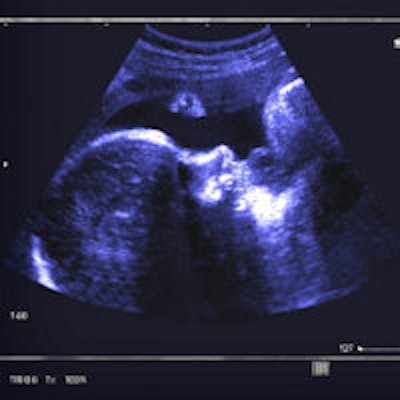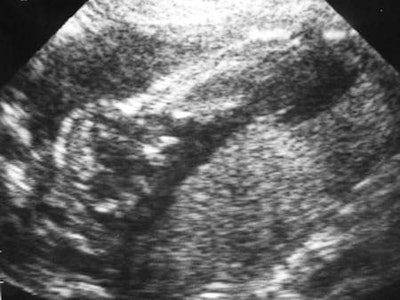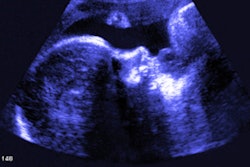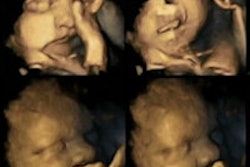
The development of ultrasound in obstetric care has transformed the experience of pregnancy and has been of inestimable value to women. As a medical student in the mid-1970s, I remember my consultant confidently diagnosing a molar pregnancy on a recently acquired ultrasound machine. Since then, medical imaging has completely changed clinical practice.1,2
Malcolm Nicolson and John Fleming have done us a great service in writing a new book, Imaging and Imagining the Fetus: The Development of Obstetric Ultrasound.3 It looks in detail at the work of the pioneers, concentrating on the U.K. researchers Ian Donald, Tom Brown, and Stuart Campbell.
 The one ton (1,016 kg) diasonograph machine was sometimes known as the "dinosaurograph." The heavy gantry was important because of the need for a stable scanning platform. This photo was taken in 1972.
The one ton (1,016 kg) diasonograph machine was sometimes known as the "dinosaurograph." The heavy gantry was important because of the need for a stable scanning platform. This photo was taken in 1972.Throughout his career, Donald in particular was concerned with ethical and moral issues in gynecology and obstetrics. Ultrasound raises many ethical issues, including those of antenatal screening for fetal anomalies, fetal sex determination, and selective termination of pregnancy. A strength of the book is the depth of discussion of ethical issues and the ethical and social impact of ultrasound.
 Ian Donald was always concerned with the ethical and moral issues in gynecology and obstetrics.
Ian Donald was always concerned with the ethical and moral issues in gynecology and obstetrics.
The social, psychological, and medical implications of obstetric ultrasound are more complex than might be first imagined. We need to consider carefully the use of medical technology, and we need to approach our images in a critical manner. Medical technology is not always as benign in its outcomes as we imagine.
Our technology should always be applied in a humane and personal manner. The real-time image makes the fetus present as a baby with movements readily visible, and Donald was always opposed to a mechanistic approach to obstetric care. The body is not a machine and doctors are not mechanics. This book is warmly recommended and will encourage a thoughtful and humane approach to medical technology as envisioned by Donald, as well as giving a masterful account of the development of modern antenatal scanning.
At the memorial service for Donald, James Willocks said that, "If you seek for his memorial, look around you. In every maternity hospital you will see ultrasound in use. A great discovery by a great man."4 Donald characterized himself as "having a continuing childish interest in machines, electronic or otherwise." His talent as a young man was appreciated, and Donald was appointed to the Regius Chair of Midwifery at the University of Glasgow in 1954.
Whilst working in London, Ian Donald had come across the work of John Wild on early applications of ultrasound and became interested in the idea that ultrasound could be used for distinguishing solid from cystic swellings. Donald visited the research department of the boilermakers Babcock & Wilcox at Renfrew, Scotland, and saw their industrial ultrasound flaw detector.
 The grave of Ian Donald in Paglesham: "In loving memory, Ian Donald, 1910-1987, Regius Professor of Midwifery, Glasgow, pioneer of medical ultrasound."
The grave of Ian Donald in Paglesham: "In loving memory, Ian Donald, 1910-1987, Regius Professor of Midwifery, Glasgow, pioneer of medical ultrasound."
He returned on 21 July 1955 and took with him a collection of pathological samples such as fibroids and ovarian cysts. Donald was very encouraged by the results. In 1956, Thomas (Tom) Brown, who worked at Kelvin & Hughes, heard of the interests of Donald and made contact with him. Tom Brown saw the problems that Donald was having and was able to supply Donald with a borrowed Mk 4 A-scope and a 35-mm oscilloscope scanner.
In 1956, Donald and Brown were joined by John MacVicar as a registrar in training. The three of them made an intensive investigation into the value of ultrasound in differentiating between cysts, fibroids, and other abdominal tumors. Ian Donald, John MacVicar, and Tom Brown appeared in print in Lancet on 7 June 1958 under the somewhat dry title of "Investigation of abdominal masses by pulsed ultrasound." This is probably the most important paper on medical diagnostic ultrasound ever published. In more than nine pages it described the experience of 100 patients with 12 illustrations of B-mode sonograms of the gravid uterus, ovarian cysts, fibroids, and ascites, as well as normal and pathological conditions. The safety of diagnostic ultrasound also was discussed, and this was to be a continuing concern for Donald.
In 1959, Ian Donald determined that echoes could be obtained from the fetal head, and his group used head measurement to assess fetal size and growth. The new Queen Mother's Hospital opened in Glasgow in 1964 (described by newspapers as a sort of holiday camp!), and fetal cephalometry became the standard method to assess intrauterine growth.
By 1961, Donald had seen ultrasound as being ancillary to radiology and he speculated on what might be achieved in time in the hands of radiologists were they to embrace the technique. There was a comprehensive ultrasonic diagnostic department installed alongside the department of radiology at the Queen Mother's Hospital. However, in 1966, Donald was to exclaim that the work load was beginning to rise at a rate which threatened to become unmanageable. Donald said that "no less than 28% had undergone ultrasonic examination at some time in pregnancy."
 Ultrasound has changed the perception of the fetus. Images like this one taken in 1985 have a powerful social meaning, and for many people are the first cherished pictures of a child.
Ultrasound has changed the perception of the fetus. Images like this one taken in 1985 have a powerful social meaning, and for many people are the first cherished pictures of a child.By 1969, ultrasound techniques were established, but it took many years for radiologists to fully embrace the technique. The attitude of radiologists is now difficult to understand when the importance of ultrasound in radiology departments is obvious. Donald was an introduction to the theme in 1975 when he said that, "Sonar indeed employs a different energy spectrum from that of roentgenology and the information yield is consequently different, but the whole ever-increasing science and art of existing visual diagnostic techniques can now embrace new horizons by adopting sonar not as a rival but as a complementary discipline. Whether the world of radiology likes it or not, it will assuredly come to recognize and meet the challenge in the future."
Dr. Adrian Thomas is chairman of the International Society for the History of Radiology and honorary librarian at the British Institute of Radiology.
References
- Thomas AMK, Banerjee, AK. The History of Radiology. Oxford: Oxford University Press; 2013.
- Thomas AMK, Banerjee AK, Busch U. Classic Papers in Modern Diagnostic Radiology. Berlin: Springer Verlag; 2005.
- Nicolson M, Fleming JEE. Imaging and Imagining the Fetus: The Development of Obstetric Ultrasound. Baltimore: Johns Hopkins University Press; 2013.
- Willocks J, Barr W. Ian Donald, a Memoir. London: RCOG Press; 2004.
The comments and observations expressed herein do not necessarily reflect the opinions of AuntMinnieEurope.com, nor should they be construed as an endorsement or admonishment of any particular vendor, analyst, industry consultant, or consulting group.



















